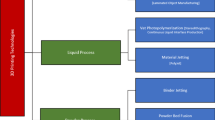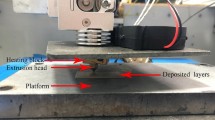Abstract
The present paper describes the influence of both flexure quasi-static and fatigue loading on polyamide 12 (PA12) specimens fabricated by fused filament fabrication (FFF) and selective laser sintering (SLS) processes. Rectangular prisms (ISO 178:2010) of polymer were printed and tested under sinusoidal three-point bending fatigue loading at a frequency of 5 Hz. The differences in porosity, surface roughness, and degree of crystallinity are systematically measured and linked to the mechanical fatigue properties. Fatigue analysis in the visco-elastic domain of the polymer is fully described, from fatigue behavior to energy analysis. Here, we have shown that the fatigue properties of the FFF specimens are found to be higher than those of the SLS specimens, despite their lower degree of crystallinity (more than four times). The presence of pores and their growth during fatigue tests in the sintered PA12 specimen seem to be responsible. The fatigue loss factor analysis shows that at lower stress levels, PA12 material reveals its characteristic slight visco-elastic dissipation and heating as its lifetime was exhausted. Also, the obtained results of additively manufactured PA12 were compared with those of materials obtained by injection molding (IM) and extrusion techniques. The quasi-static flexural properties of PA12 obtained by FFF and SLS processes reveal better characteristics compared to IM and extruded specimens. However, the fatigue properties of the SLS-processed polymer are 24% and 40% less than those of materials obtained by IM and extrusion.
















Similar content being viewed by others
Availability of data
Not applicable.
References
Dizon JRC, Espera AH, Chen QY, Advincula RC (2018) Mechanical characterization of 3D-printed polymers. Addit Manuf 20:44–67
Safai L, Cuellar JS, Smit G, Zadpoor AA (2019) A review of the fatigue behavior of 3D printed polymers. Adv Manuf 28:87–97. https://doi.org/10.1016/J.ADDMA.2019.03.023
Melnikova R, Ehrmann A, Finsterbusch K (2014) 3D printing of textile-based structures by Fused Deposition Modelling (FDM) with different polymer materials. IOP Conf Ser Mater Sci 62
Bakarich SE, Gorkin R, Panhuis MIH, Spinks GM (2014) Three-dimensional printing fiber reinforced hydrogel composites. ACS Appl Mater Interfaces 6(18):15998–16006
Kalita SJ, Bose S, Hosick HL, Bandyopadhyay A (2003) Development of controlled porosity polymer-ceramic composite scaffolds via fused deposition modeling. Mater Sci Eng C Biol Sci 23(5):611–620
Melchels FPW, Feijen J, Grijpma DW (2010) A review on stereolithography and its applications in biomedical engineering. Biomaterials 31(24):6121–6130
Murphy SV, Atala A (2014) 3D bioprinting of tissues and organs. Nat Biotechnol 32(8):773–785
Rengier F, Mehndiratta A, von Tengg-Kobligk H, Zechmann CM, Unterhinninghofen R, Kauczor HU, Giesel FL (2010) 3D printing based on imaging data: review of medical applications. Int J Comput Assist Radiol Surg 5(4):335–341
Wu GH, Hsu SH (2016) Review: Polymeric-based 3D printing for tissue engineering. J Med Biol Eng 35(3):285–292
Stansbury JW, Idacavage MJ (2016) 3D printing with polymers: challenges among expanding options and opportunities. Dent Mater 32(1):54–64
Crivello JV, Reichmanis E (2014) Photopolymer materials and processes for advanced technologies. Chem Mater 26(1):533–548
Lee JY, An J, Chua CK (2017) Fundamentals and applications of 3D printing for novel materials. Appl Mater Today 7:120–133
Liu R, Wang Z, Sparks T, Liou F, Newkirk J (2017) Aerospace applications of laser additive manufacturing. Woodh Pub Ser Elect 88:351–371
Wohlers TT, Associates W (2012) Wohlers report 2012: Additive manufacturing and three-dimensional printing state of the industry annual. Wohlers Associates
Wohlers TT, Associates W. (2020) Wohlers report 2020: 3D printing and additive manufacturing state of the industry. Wohlers Associates
Mohamed OA, Masood SH, Bhowmik JL (2015) Optimization of fused deposition modeling process parameters: a review of current research and future prospects. Adv Manuf 3:42–53. https://doi.org/10.1007/s40436-014-0097-7
Lanzotti A, Grasso M, Staiano G, Martorelli M (2015) The impact of process parameters on mechanical properties of parts fabricated in PLA with open-source 3-D printer. Rapid Prototyp J 21:604–617
Quinsat Y, Lartigue C, Brown CA, Hattali L (2017) Characterization of surface topography of 3D printed parts by multi-scale analysis. IJIDeM 12(3):1007–1014. https://doi.org/10.1007/s12008-017-0433-9
Terekhina S, Skornyakov I, Tarasova T, Egorov S (2019) Effects of the infill density on the mechanical properties of nylon specimens made by filament fused fabrication. Technologies 7(3):57. https://doi.org/10.3390/technologies7030057
Luzanin O, Movrin D, Plancak M (2014) Effect of layer thickness, deposition angle, and infill on maximum flexural force in FDM-built specimens. J Technol Plast 39(1)
Turner BN, Scott AG (2015) A review of melt extrusion additive manufacturing processes: II. Materials, dimensional accuracy, and surface roughness. Rapid Prototyp J 21(3):250–261
Marimuthu K & al (2016) Bi-directional bending fatigue performance of unreinforced and carbon fiber reinforced polyamide 66 spur gears. Int J Prec Eng Manuf 17(8): 1025–1033
Mary T, Schwartz P (1992) Bending and torsional fatigue of nylon 66 monofilaments. J Appl Polym Sci 46(11):2023–2032
Hooreweder B et al (2013) On the difference in material structure and fatigue properties of nylon specimens produced by injection molding and selective laser sintering. Polym Test 32(5):972–981
Gomez-Gras G et al (2018) Fatigue performance of fused filament fabrication PLA specimens. Mater Des 140:278–285
John L, Huang A (2013) Fatigue analysis of FDM materials. J Rap Prototyp 19(4):291–299
Mejri M et al (2017) Fatigue life and residual strength of a short-natural-fiber-reinforced plastic vs nylon. Comp Part B: Eng 110:429–441
Casavola C, Cazzato A, Moramarco V, Pappalettera G (2017) Residual stress measurement in fused deposition modelling parts. Polym Test 58:249–255
Ang KC, Leong KF, Chua CK, Chandrasekaran M (2006) Investigation of the mechanical properties and porosity relationships in fused deposition modelling-fabricated porous structures. Rapid Prototyp J 12(2):100–105
Equbal A, Sood AK, Mahapatra SS (2010) Prediction of dimensional accuracy in fused deposition modelling: a fuzzy logic approach. Int J Product Qual Manag 7(1):22–43
Sood AK, Ohdar RK, Mahapatra SS (2010) Parametric appraisal of mechanical property of fused deposition modelling processed parts. Mater Des 31(1):287–295
Sood AK, Ohdar RK, Mahapatra SS (2012) Experimental investigation and empirical modelling of FDM process for compressive strength improvement. J Adv Res 3(1):81–90
Letcher T, Waytashek M (2014) Material property testing of 3d-printed specimen in PLA on an entry-level 3d printer. Proc Asme Int Mech Eng Cong expos 2a
Afrose MF, Masood SH, Lovenitti P, Nikzad M, Sbarski I (2016) Effects of part build orientations on fatigue behaviour of FDM-processed PLA material. Prog Addit Manuf 1(1–2):21–28
Caulfield B, McHugh PE, Lohfeld S (2007) Dependence of mechanical properties of polyamide components on build parameters in the SLS process. J Mater Process Technol 182(1–3):477–488
Wegner A, Witt G (2012) Correlation of process parameters and part properties in laser sintering using response surface modeling. Phys Procedia 39:480–490
Negi S, Dhiman S, Sharma RK (2015) Determining the effect of sintering conditions on mechanical properties of laser sintered glass filled polyamide parts using RSM. Measurement 68:205–218
Tontowi AE, THC C (2001) Density prediction of crystalline polymer sintered parts at various powder bed temperatures. Rapid Prototyp J 7(3):180–184
Griessbach S, Lach R, Grellmann W (2010) Structure–property correlations of laser sintered nylon 12 for dynamic dye testing of plastic parts. Polym Test 29(8):1026–1030
Hooreweder BV, Kruth JP (2014) High cycle fatigue properties of selective laser sintered parts in polyamide 12. CIRP Ann 63(1):241–244
Miller A et al (2017) Fatigue of injection molded and 3D printed polycarbonate urethane in solution. Polymer 108:121–134
ISO 10993-1 (2018) Biological evaluation of medical devices—part 1: evaluation and testing within a risk management process, International Organization for Standardization, Vernier, p 41
EOS GmbH Product Information. Available online: www.eos.info/material-p (accessed on 9 November 2018)
Borzan CS, Berce P, Chezan H, Sabau E, Radu SA, Ridzon M (2013) Physico-mechanical properties characterization of the parts from PA2200 manufactured by selective laser sintering technology. Acad J Manuf Eng 11:108–113
ISO 178:2010 (2010) Plastics – determination of flexural properties. ISO/TC 61/SC 2, Ed. Switzerland: International Standards Organization
Terekhina S, Tarasova T, Egorov S, Skornyakov I, Guillaumat L, Hattali ML (2020) The effect of build orientation on both flexural quasi-static and fatigue behaviours of filament deposited PA6 polymer. Int J Fatigue 140:105825
Gordelier TJ, Thies PR (2019) Optimising the FDM additive manufacturing process to achieve maximum tensile strength: a state-of-the-art review. Rapid Prototyp J 25(6):953–971. https://doi.org/10.1108/RPJ-07-2018-0183
ASTM D3418115, standard test method for transition temperatures and enthalpies of fusion and crystallization of polymers by differential scanning calorimetry. ASTM Volume 08.02 Plastics (II): D3222–D5083. Available: www.astm.org
Blaine RL (2002) Thermal applications note, s.l.: polymer heats of fusion
Dupin S (2012) Etude fondamentale de la transformation du polyamide 12 par frittage laser: mécanismes ohysico-chimiques et relations microstructures/propriétés. Dissertation, INSA de Lyon
ASTM D7774-12 (2013) Standard test method for flexural fatigue properties of plastics. D20.10.24, Ed. West Conshohocken, PA: ASTM International. [Online]. Available: www.astm.org
Katunin A (2018) Criticality of the self-heating effect in polymers and polymer matrix composites during fatigue, and their application in non-destructive testing. Polymers 11:19. https://doi.org/10.3390/polym11010019
Forster A M (2015) Materials testing standards for additive manufacturing of polymer materials: state of the art and standards applicability. US Department of Commerce, National Institute of Standards and Technology
Caulfield B, McHugh PE, Lohfeld S (2007) Dependence of mechanical properties of polyamide components on build parameters in the SLS process. J Mater Process Technol 182:477–488
Tuan Noraihan Azila Tuan R et al (2016) Comparison of mechanical properties for polyamide 12 composite-based biomaterials fabricated by fused filament fabrication and injection molding. AIP Conference Proceedings 1791(1), AIP Publishing
Efunda (2019) Polyamide. Material Properties. Datasheet. [En ligne] Available at : https://www.efunda.com/materials/polymers/properties/polymer_datasheet.cfm?MajorID=PA&MinorID=81
Biron M (2018) Thermoplastics and thermoplastic composites. Ss.l.:William Andrew
Li P, Lee PD, Maijer DM, Lindley TC (2009) Quantification of the interaction within defect populations on fatigue behavior in an aluminum alloy. Acta Mater 57(12):3539–3548
Lesser AJ (1995) Changes in mechanical behavior during fatigue of semicrystalline thermoplastics. J Appl Polym Sci 58(5):869–879
Hooreweder BV, Moens D, Boonen R, Kruth JP, Sas P (2013) On the difference in material structure and fatigue properties of nylon specimens produced by injection molding and selective laser sintering. Polym Test 32:972–981
Hooreweder BV, Kruth JP (2014) High cycle fatigue properties of selective laser sintered parts in polyamide 12. CIRP Ann 63(1):241–244
GEHR Plastics (2019). GEHR PA12 TR Clearly the new kind of a anti-corrosion materials. Datasheet [En ligne] Available at: https://www.alro.com/datapdf/plastics/plasticsbrochures/brochure_gehrpa12_tr.pdf
Seignobos EM (2009) Compréhension des mécanismes physiques de fatigue dans le polyamide vierge et renforcé de fibres de verre. Dissertation, INSA de Lyon
Acknowledgments
The authors thank Pichereau Benoit and Gallegos Linamaria from Arts et Métiers ParisTech, Campus Angers, for helpful discussions and technical support.
Funding
The authors disclosed receipt of the following financial support for the research, authorship, and/or publication of this article: This study was supported by the French-Russian collaboration project and financed by the Ministry of Education and Science of the Russian Federation as part of the implementation of the state task № 0707-2020-0034.
Author information
Authors and Affiliations
Corresponding author
Ethics declarations
Conflict of interest
The authors declare that they have no conflicts of interest.
Code availability
Not applicable.
Additional information
Publisher’s note
Springer Nature remains neutral with regard to jurisdictional claims in published maps and institutional affiliations.
Rights and permissions
About this article
Cite this article
Terekhina, S., Tarasova, T., Egorov, S. et al. On the difference in material structure and fatigue properties of polyamide specimens produced by fused filament fabrication and selective laser sintering. Int J Adv Manuf Technol 111, 93–107 (2020). https://doi.org/10.1007/s00170-020-06026-x
Received:
Accepted:
Published:
Issue Date:
DOI: https://doi.org/10.1007/s00170-020-06026-x




